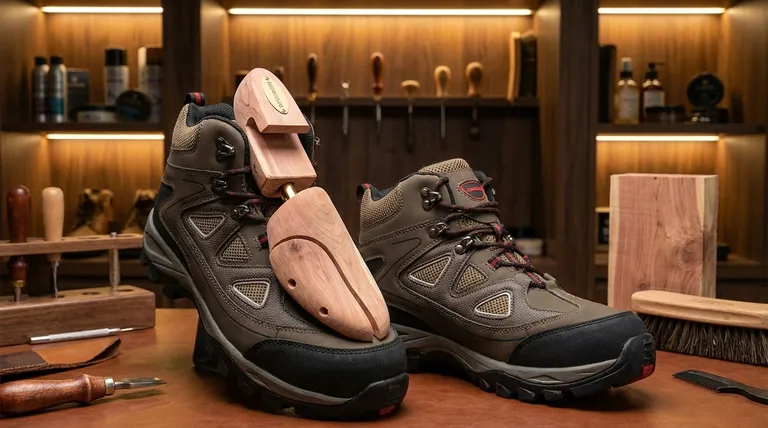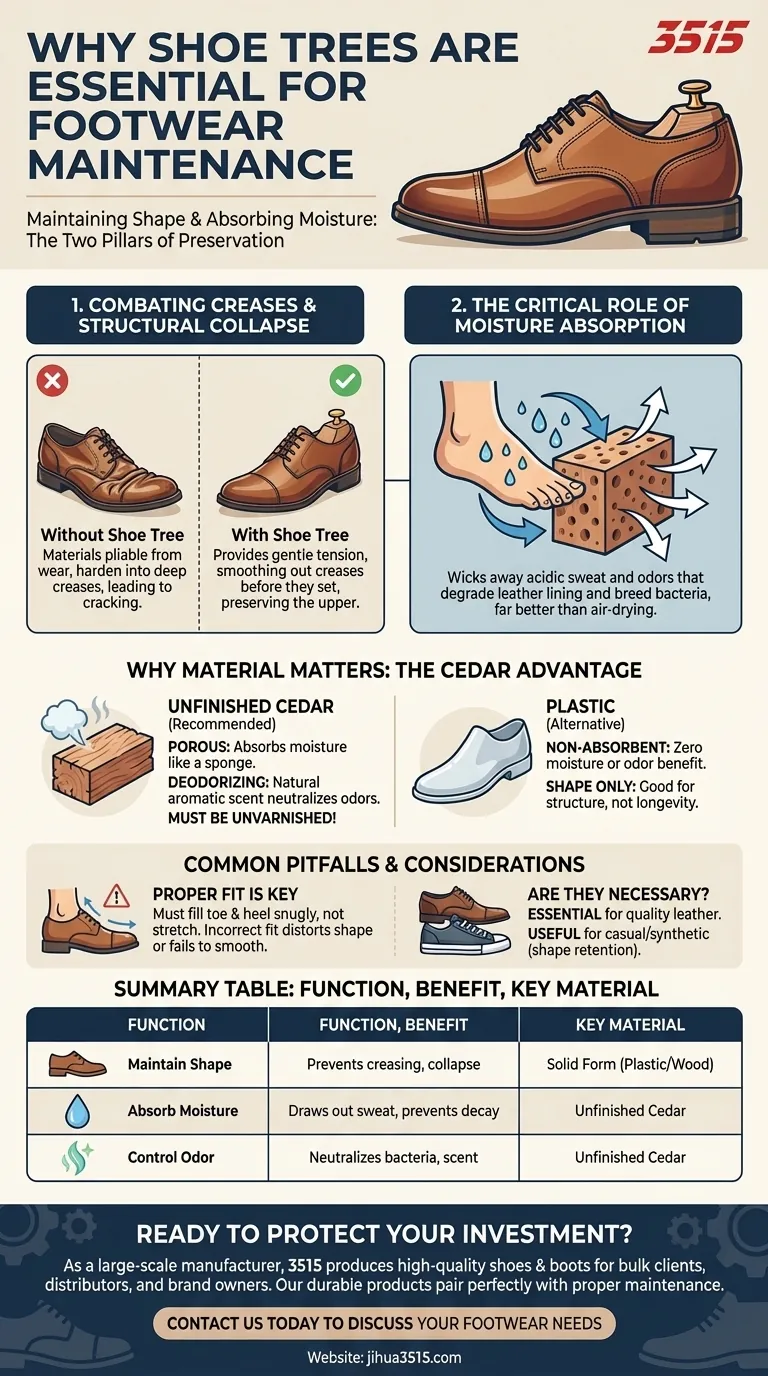At their core, shoe trees are essential because they perform two critical functions: they maintain the original shape of your footwear and absorb damaging moisture. By providing a solid form, they prevent the leather or fabric uppers from creasing and cracking, while materials like cedar actively draw out sweat and odor.
The primary purpose of a shoe tree is not merely aesthetic; it is a preservation tool that actively combats the two main forces that degrade footwear—structural collapse from creasing and material decay from moisture.

The Two Pillars of Footwear Preservation
To protect your footwear investment, you must address the twin threats of physical deformation and internal moisture damage. Shoe trees are uniquely designed to counter both.
Combating Creases and Structural Collapse
When you wear your shoes, the heat and moisture from your feet make the materials (especially leather) more pliable. As they cool and dry, they contract and harden into the creases formed during wear.
A shoe tree provides gentle, consistent tension, smoothing out these creases before they become permanent. This prevents the deep folds that eventually lead to cracking and a breakdown of the shoe's upper.
The Critical Role of Moisture Absorption
The inside of a shoe is a harsh environment. Foot sweat is acidic and, if left to sit, will slowly degrade the leather lining, causing it to become brittle and crack.
Furthermore, this moisture creates a perfect breeding ground for odor-causing bacteria. A quality shoe tree acts as a wick, drawing this moisture out of the shoe's interior far more effectively than air-drying alone.
Why Material Matters: The Cedar Advantage
While any form can help with shape, the material of the shoe tree determines its effectiveness in managing moisture and odor.
Unfinished Cedar: The Key to Absorption
The most effective shoe trees are made from unfinished American cedarwood. It is crucial that the wood is left raw and unvarnished.
A lacquered or painted surface seals the wood, completely negating its ability to absorb moisture. Unfinished cedar's porous nature is what allows it to act like a sponge.
Natural Deodorizing Properties
Beyond its absorbent qualities, cedar has a pleasant, aromatic scent. This natural fragrance helps to neutralize odors within the shoe, leaving them smelling fresh between wears.
Common Pitfalls and Considerations
Using shoe trees correctly is just as important as using them at all. Certain mistakes can limit their effectiveness or even cause harm.
Plastic vs. Wood
Plastic shoe trees are a budget-friendly option. While they successfully provide the internal structure needed to maintain a shoe's shape, they offer zero moisture absorption or deodorizing benefits. They solve only half the problem.
The Importance of a Proper Fit
A shoe tree must fit correctly. It should fill the toe box and heel snugly without actively stretching the material. A tree that is too large can distort the shoe's shape, while one that is too small won't provide enough tension to smooth out creases.
Are They Necessary for Every Shoe?
The value of a shoe tree correlates with the quality and material of the footwear. For high-quality leather dress shoes or boots, they are a non-negotiable part of maintenance. For casual canvas sneakers or shoes made of synthetic materials, their primary benefit is shape retention and odor control, making them useful but less critical for the material's longevity.
Making the Right Choice for Your Footwear
Your choice of shoe tree should align directly with the type of footwear you want to preserve.
- If your primary focus is preserving expensive leather dress shoes or boots: An unfinished cedar shoe tree with a full heel is a mandatory investment to protect their structure and material integrity.
- If your primary focus is maintaining the shape of casual sneakers: A simple plastic or basic wood shoe tree is sufficient to prevent collapsing and creasing.
- If your primary focus is controlling odor across all your footwear: Cedar is the only material that actively absorbs moisture and deodorizes naturally.
Ultimately, using a properly fitted shoe tree is the single most effective action you can take to extend the life and appearance of your valued footwear.
Summary Table:
| Function | Benefit | Key Material |
|---|---|---|
| Maintain Shape | Prevents creasing and structural collapse | Solid Form (Plastic/Wood) |
| Absorb Moisture | Draws out sweat, prevents material decay | Unfinished Cedar |
| Control Odor | Neutralizes bacteria with natural scent | Unfinished Cedar |
Ready to protect your footwear investment? As a large-scale manufacturer, 3515 produces a comprehensive range of high-quality shoes and boots for distributors, brand owners, and bulk clients. Our expertise ensures durable products that pair perfectly with proper maintenance tools like shoe trees. Let's discuss how we can meet your footwear needs. Contact us today to learn more about our production capabilities!
Visual Guide

Related Products
- Safety Footwear Wholesale Manufacturer for Custom OEM/ODM Production
- Wholesale Comfortable Business Casual Shoes Custom Manufacturing
- Wholesale Safety Footwear Manufacturer for Bulk & Custom OEM Orders
- Wholesale Anti-Smash & Puncture-Proof Safety Shoes Custom Manufacturing for Brands
- Premium KPU Injection Athletic Style Safety Shoes
People Also Ask
- How do safety shoes contribute to cost savings for companies? A Strategic Investment in Risk and Cost Management
- What are the differences between steel toe, composite toe, and alloy toe Wellington boots? Choose the Right Safety Toe for Your Job
- What are OSHA approved shoes? Understanding the Correct Standards for Workplace Safety
- How long can you wear safety boots? The Lifespan is Determined by Wear, Not Time
- What are the cultural perspectives on wearing shoes in the house? A Guide to Home Etiquette & Hygiene



















